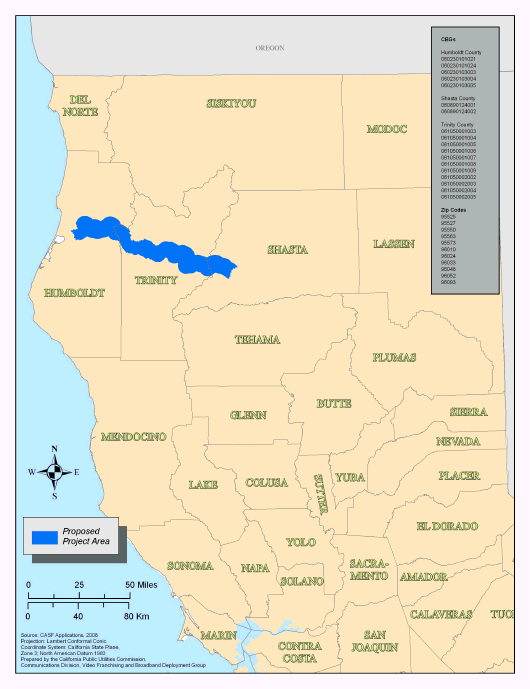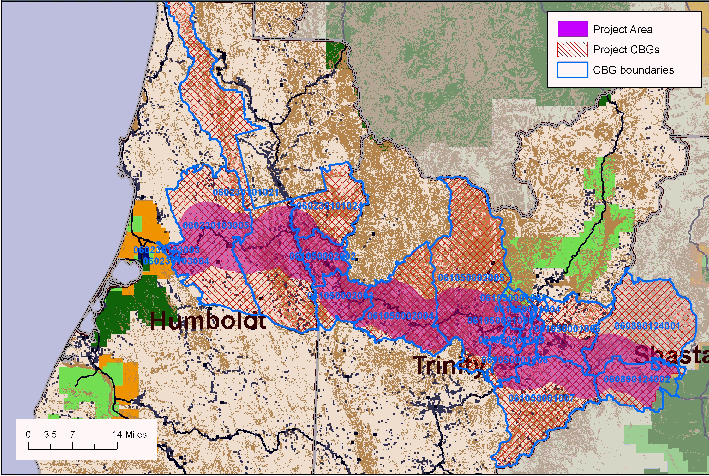by Bob | Jan 29, 2009 | Broadband/Internet, Local Tech Notes
My latest Tech Beat regarding broadband issues and controversies is in the Times-Standard this morning. If you are planning on attending the luncheon on Feb. 2, please make your reservations now as we need to get as accurate an account as possible in later today.
I wonder why the Tech Beat articles don’t appear in the T-S RSS feeds…
by Bob | Jan 23, 2009 | Broadband/Internet, Local Tech Notes
Those of us who already have high speed access have a tendency to get complacent about broadband issues until the next fiber break happens. But some have been working diligently to find ways to improve our telecommunications infrastructure, not waiting for the next disaster and knowing many areas of the region remain un-served or under served. In one fell swoop, one project may solve many of these issues. The California Public Utilities Commission appears prepared to award over $7 million to a company called Broadband Associates through the California Advanced Services Fund to build a second fiber line from I – 5 to Eureka along the Highway 299 corridor.
Other proposed projects such as the IP Networks was working on in conjunction with PG&E have not come to fruition. That project would have used PG&E towers closer to much less populated Highway 36 corridor and, as far as I know made no provisions for access point along the way. The 299 route is more difficult and more expensive but the project includes access for wireless providers to service communities from Blue Lake to Weaverville.
There has been some strong opinions expressed on the RTC mailing list about the wisdom and viability of this project and why we haven’t heard much about it until just now. I think many of the concerns over transparency and accountability should be address to the CPUC itself.
Yesterday I spoke with Michael Brinskele, CEO of Broadband Associates about their proposal. Michael has had an interest in our region for quite a while. He attended the last Broadband Forum and has been in discussion with CENIC and people from Redwood Coast Connect. Their application for the CASF funds has come after looking carefully at the region’s issues and opportunities.
From our conversation I felt he is quite aware of the challenges such a project holds both for the build itself and its economic viability. He believes Broadband Associates has a strong business plan to make this work. However, since there is still a great deal of planning to do before the February 20 deadline they are purposively not making any public noise about this project in order to not raise expectations or over promise. On the other hand he is pleased there is great interest in this project and has expressed to me an openness to any questions or concerns from people who would like to learn more. Those questions can be addressed to info@broadbandassoc.com. 

by Bob | Aug 23, 2008 | Broadband Forum, Broadband/Internet, Local Tech Notes
Much coverage in the press has and will appear over Broadband Forum IV, but just in case they miss something herewith are notes provided by Larry Goldberg with a few minor edits from me. I understand at some point PowerPoint presentations will be posted on the Redwood Coast Connect web site. BTW, this was an excellent event. Much thanks are due to Connie Stewart and Patty Berg’s office, and to Redwood Coast Rural Action which foot the bill.
Opening Remarks - Rollin Richmond – RCRA
Governor’s broadband task force – findings released
- Community Service District’s have been approved to provide broadband
- Need to focus on providing “last mile†broadband to rural California
Peter Pennekamp, Humboldt Area Foundation
- Broadband is essential to commerce, education and community networking
- Too many people are still on dial-up; we need to correct this
- Governor signed law (despite telephone co. objections) to allow community services provide broadband service
County Updates:
Del Norte – Jeannine
- 5 Gb pipe from Charter
- cable modem up to 16 Mb service
- competitive telephone service soon
- plan to extend pipe to Eureka through Klamath & Orick
- redundancy with S. Oregon
Trinity co. – Barbara
- Working on cell tower project – 42 sites planned
- No broadband is currently available in Trinity
- Weaverville may have fiber soon
- Getting CalTrans to include fiber in all new highway projects
- Customer survey by Community Services Dist. (28% don’t own computer & most who do are on dial-up currently)
- Soliciting proposals for technology study (last mile)
Humboldt Co. – Amy Nelson
Office of Emergency Services – working on basic communications infrastructure
National incident management training
Mendocino Co.
- Broadband issues have been a concern for over 18 years
- Digital California & CNIC have provided high-speed service to schools
- Rural tele-medicine project
- Tower microwave system installed
Yurok tribe – Paul Romero
- Working on microwave path from Crescent City (HUD grant) will complete project
- Redwood Cost Connect Project Update
Project overview – Steve Carp, Project Manager
- Mapping broadband usage and technology in four Northcoast counties
- Funding from Ca. Emerging Technology Fund, HAF, RREDC, CDBG and others
- Project scope – four counties (Del Norte, Humboldt, Trinity and Mendocino) which represent an area bigger than 4 states in U.S.
- Surveys & interviews conducted to determine a) level of interest in broadband, b) price points & c) broadband availability
- Aggregating demand for small rural areas
- Self-selecting surveys coupled with telephone surveys
- Over 1,100 responses were received over region – cross-section of all areas
- Selected results:
- 46% of residential have broadband/ 33% rely on dial-up
- 64% felt broadband was critical
- 60% of respondents say they’re willing to pay more
- Most would pay at least $30-40/mo.
- Although broadband access is high, only 50% are satisfied (downtime, cost of service & competition)
- Only 54% of businesses are satisfied with current broadband
- 73% of business would pay up to $75/mo. for broadband
- Helping one household at a time
- Educating people about importance of broadband
Community meetings – Tina Nerat
- Mendocino had high turn-out (90 people turned out to Ft. Bragg meeting)
- People who attended were cross-section of community
- In Willow Creek it was mostly Seniors attending
- Telecom providers have really expanded
- Study gave good opportunity to chart actual broadband deployment
- Wireless is a new entry into the market and is providing last-mile access
- CPUC CASF fund – only telecom providers can apply
- Actual applications have not been made public – we don’t know who eventually applied
- Backhaul (middle mile) – redundancy is major issue
- More diversity of choices needed (more competition)
- Alternative scenarios – need “ladders with rungs†for redundancy
- 60% of rural communities are unserved or under-served
- Need for anchor tenants for broadband
- Too many small businesses, not enough large “anchorsâ€
- Middle mile is greatest barrier to last-mile solutions
- Will probably require subsidies for middle-mile to overcome problem
Community meetings – Connie Stewart
- Draft Telecom element written for General Plan
- Large next-step section planned
- Calnet II contract and E-rate implications
- Public/private partnership opportunities:
- CASF
- Other local opportunities
- SB1191 – community service districts can provide broadband
- No clear road to encourage investment – difficult to make business case
- Fed/state subsidies need to be revamped for rural areas like the Redwood Coast
- JPA could be good way to create public/private partnership to solve backhaul issues and right-of-way issues (first JPA between Humboldt and Trinity Co. for fiber)
- CASF will influence next efforts
- Broadband awareness/education
- Local leadership (alliances) are necessary to move this forward
- Determine how to keep maps up to date
- Business case needs to be made for secondary alternate routes
- Trinity Co. applied for separate funding from CPUC and are now putting in their own towers
Keynote Speaker – Susan Waters, Ca. Emerging Technologies Fund
- “Rural is on California’s radarâ€
- Relationship building carries project
- The RCC study is a ground-breaking initiative to build community support for broadband
- No one solution fits all (and solves all problems)
- Understand resources and assets available to leverage
- It takes local initiative to get things done
- Second round of CASF coming soon
Increasing broadband access in our Region – Local providers (General comments: All offering wider coverage. Many seemed to have issues with government policies and permitting that slows progress and increases costs).
- Velocity Technology (couldn’t be here but Tina gave update)
- 101 NetLink (offers redundancy already, but have had few takers)
- Cascadia Wireless
- SuddenLink
- Broadband Associates (builders of fiber networks)
- Mendocino Community Network
- AT&T
- CENIC
Issues discussed:
- Issues with National Parks service
- 2000 dial-up customers today in Mendocino
- CENIC recognized problems with infrastructure
- NetLink just lit up 200 Mb channel
- Market for redundancy is questionable (101 Netlink)
- Lost Coast Communications (LCC) announced redundant fiber project with partner (bringing fiber in from Cottonwood). LCC project is going along PG&E right-of-way and is planned to be completed by late 1st quarter ’09. They are in negotiations with SuddenLink to provide redundant bandwidth. Large commercial and institutional clients are primary wholesale market. (see this post).
Permit Panel – the best way to work together
Issues:
- CEQA – many responsible agencies
- Lead agencies – cities, counties and CalTrans
- Dept. of Fish & Game – makes comments and reviews EIRs
- Coastal Commission – reputation is both good and bad for good reason
- Some forms of development are exempt from permits
- Several Federal wildlife protection jurisdictions and levels of regulations
- Get projects submitted as soon as possible
- Governor has issued mandate to streamline broadband approval process
- Encroachment permit has been revised
- Conflict resolution process has been created
- CalTrans utilizes fiber extensively within their own department
- Lots of access for future utility providers within new CalTrans roads (e.g. at Confusion Hill they installed 6†& 12†conduits
- Allison Detner (Ocean projects Coastal Commission)
- Concern about older towers with lattice-work attracting Ospreys (need to avoid towers providing habitat for bird species)
- Directional drilling is a new technology which has little to no impact on wildlife habitat
National Policy Update
- Alternative Scenarios – middle mile – Connie & Jacqueline
- Multiple alternate routes discussed: highways 199, 299, 101
- last mile service is still critical – wireless may be the best solution
- “Redundancy†is a misused word – alternate paths is more appropriate
- Access Humboldt: broadband policy project – inform public policy for advocacy for localism (research for broadband policy for community needs)
Susan Estrada – what’s happening in the treetops at the Federal Level
- The reality – attracting investment in rural areas is nearly impossible
- Ubiquitous infrastructure is only possible with urban density
- Everyone is talking broadband now on the political level – something is going to change
- Today’s federal subsidies are primarily geared towards wired telephone service
- Current subsidies: Universal service fund
- No national broadband policy
- Fixed and mobile wireless will be the ultimate rural last mile solution
- What’s the definition of broadband? (“instant gratification�)
- The definition of broadband is constantly changing
- We need a useful Universal Service for broadband
- Other financial incentives for encouraging high cost build-out
- A deep understanding of the nature of rural problems
- Getting there from here:
- Grassroots organizing (local advocates) and treetops (elected officials) need to cooperate for success
- Pressure your local federal elected officials to work on solution
- ]Pressure your local state elected officials to pressure the state to work with the federal government on solutions
- Provide the data that will allow bureaucrats to understand the needs, the barriers, the solutions in your communities. Document the stories. Share the stories. YouTube the stories.
- Follow the money!
Sean McLaughlin – what’s happening in the treetops at the Federal Level
- Federal policy is convoluted and irrational
- Comparison of speed and price – “market failure†of U.S. broadband industry
- “You will need and you are entitled to broadband Internet “ – FCC commissioner Cox
- “There’s a social obligation that everyone should participate in broadband infrastructureâ€
- “Everyone has the right to free expression of opinion and seek and receive any media regardless of frontiersâ€
- Is broadband a commodity or a right?
- Cable modem service was initially regulated by local government with cable franchises
- No regulatory structure around information services
- Pre-emption of local government was attempted on Federal level and failed
- Marketplace is not going to fix itself
- Rights of way and spectrum licenses are two main ways of regulation for broadband
- Spectrum – relocation about analog TV to digital spectrum (700 Mhz blocks were up for grabs)
- Is your ability to communicate a privilege? A commodity?
Next steps – where do we go from here?
- Task force – form working groups to meet regularly and address regional and community issues
- Address barriers to entry – educational outreach
- Develop regional & statewide lobbying effort – RCRA?
- Encourage increased competition
- Helping community service districts find funding for their area
- Fiber to the premises (a vision of the future)
- Change broadband access to a right instead of a commodity
- Meet more often & share info
- Create incentives at all levels to leverage resources for public-private partnerships
- Establish working groups to research over the year and keep the ball rolling
- “Begin with the end in mind†– think about our goals
- Collaborations between regulatory agencies
- When planning infrastructure, consider financing fiber infrastructure
by Bob | Mar 14, 2008 | Broadband/Internet, Local Tech Notes
Rich Ryan offered some exciting options in his presentation for the RTC last night. His company, Hunter Communications has a great deal of experience building fiber networks in rural areas. They seem to know the issues that confront a region like ours. They understand the physical and regulatory landscape. They also seem to be able to make economic sense out of building fiber in areas that are generally under served by the telcos.
Rich is also very community oriented and is open to partnering with anyone. He has an interest in expanding his operations in to Northern California. I am hoping we can get him started on some solutions very soon.
by Bob | Mar 12, 2008 | Broadband/Internet, Local Tech Notes
The Redwood Technology Consortium has invited Rich Ryan, CEO of Hunter Communications from Southern Oregon to speak at the monthly meeting tomorrow, March 13 at 5:30 PM. Ryan has built fiber networks in Oregon and is very interested in finding solutions for the North Coast.
Topics discussed will include:
* Hunter Communications background and current composition
* Development of fiber networks and the implementation of the Rural and
Metropolitan Area Network in Southern Oregon
* Vision for the Northern California Coastal Region and what a
regional fiber network could mean for businesses, municipalities and
other groups
* Hunter’s Plan for our region and how it fits in the “big picture”
Hunter Communications’ formed a creative public-private partnership model that leveraged pre-existing, school budgeted telecommunications funds to build a network infrastructure capable of handling regional demands, and currently servicing over 90 sites. Hunter’s efforts have resulted in unprecedented new communications and connectivity resources for a number of previously disregarded rural communities.
The meeting this month is at the Humboldt Area Foundation Conference Room. 373 Indianola Rd., Bayside.


